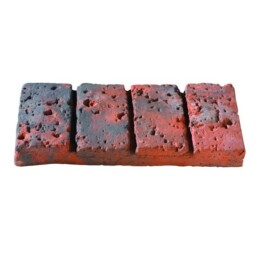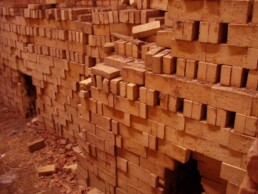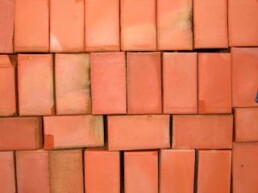Kiln Construction and Brick Firing
Kiln Construction and Brick Firing
It is during the firing that the bricks receive their strength. In the presence of high heat, the alkalies in the clay, together with small amounts of oxides of iron and other metals, are joined in chemical union with the alumina and silica in the clay to form a dense and durable mass.
A kiln is a furnace or oven in which bricks are fired or heat treated to develop hardness. Where brickmaking is done on a large scale, the firing operation is performed in a continuous-process kiln referred to as a tunnel kiln. In making brick on a small scale, firing is a periodic operation wherein the bricks are placed in the kiln, the fire started and heat developed, and then, after several days of firing, the fuel is cut off from the fire and the entire kiln and its load are allowed to cool down naturally.
The kiln is filled with well-dried bricks, stacked in the same manner as during the drying. The top of the stack in the kiln is then sealed with mud. Some openings are left through which combustion gases can escape. Pieces of sheet metal are provided to slide over the openings to control the rate at which the fire burns.
Although a range of fuels can be used in this kiln, wood or charcoal are the most common. When the kiln is at the prime heat for firing, a cherry-red hue develops (corresponding to a temperature range of 875 to 900°C). This condition is held for about 6 hours. Sufficient fuel must be available when the burning starts since the entire load of bricks might be lost if the fires were allowed to die down during the operation. Firing with wood will require four to five days.
During the firing the bricks will shrink as much as 10%. As they are taken out of the kiln they should be sorted to different grades, the main criteria being strength, irregular dimensions, cracks and sometimes discoloration and stain.
Binders
When binders are mixed with sand, gravel and water, they make for a strong and long lasting mortar or concrete.
Binders can be broadly classified as non-hydraulic or hydraulic. The hydraulic binders harden through a chemical reaction with water making them impervious to water and therefore able to harden under water. Portland cement, blast-furnance cement (super sulphated), pozzolanas and high- alumina cement belong to the hydraulic binders. High-calcium limes (fat or pure limes) are nonhydraulic since they harden by reaction with the carbon dioxide in the air. If, however lime is produced from limestone containing clay, compounds similar to those in portland cement will be formed, i.e., hydraulic lime.
Lime
Non-hydraulic lime is high-calcium limes that are produced by burning fairly pure limestone, essentially calcium carbonate, so as to drive off the carbon dioxide leaving calcium oxide or quicklime. The burning process requires a temperature of 900 to 1 100° C. Quicklime must be handled with great care because it reacts with moisture on the skin and the heat produced may cause burns. When water is added to quicklime considerable heat is evolved, expansion takes place breaking down the quick lime pieces to a fine powder and the resulting product is calcium hydroxide, also called hydrated lime, or slaked lime.
After drying the powder is passed through a 3mm sieve, and poured into bags for storage (in dry conditions) and distribution.
Burnt-clay bricks
Burnt-clay bricks have good resistance to moisture, insects and erosion and create a good room environment. They are medium in cost and have medium-to-high compressive strength.
Bricks can be made with sophisticated factory methods, simple labour-intensive methods or a range of mechanized technologies in between. The labour-intensive production methods are most suitable for rural areas where the demand for bricks is limited. The bricks produced by hand will have relatively lower quality, especially compressive strength, and will tend to have irregular dimensions. However, they are economical and require little capital investment or transportation cost. Bricks made in this manner have been used in buildings which have lasted for centuries. Their longevity has depended on the quality of the ingredients, the skill of the artisans and the climate in which they were used.
Brick Making
Four main ingredients are required for brick making: suitable clay and sand, water, fuel and manpower. The clay must be easily available, be plastic when mixed with small amounts of water, develop strength upon drying and develop hard and durable use-strength when burned.
Suitable soils contain 25 to 50% clay and silt and 50 to 75% coarser material as determined by the simple sedimentation test. The soil must be well graded. Another test consists of rolling out by hand on a flat surface a long cylinder with a 10mm diameter from moistened soil and then picking it up by one end and letting it hang unsupported. A soil is adequate for brick making if the piece of cylinder that breaks off is between 50 and 150mm long. In the bar shrinkage test, using a mould 300mm long and 5Omm wide and deep, a suitable soil should show no cracking or only a little on the surface and shrink less than 7%, i.e., less than 20mm.
The clay is obtained by chipping it out of a clay bank and when necessary, mixing it with sand to a mixture that will not crack during drying. Water is gradually added to make the clay plastic.
In making bricks, the mould must be cleaned periodically with water. Before each brick is formed, the mould is sprinkled with sand. A lump or clot of clay just slightly larger than required for a brick is rolled into a wedge shape and then in sand before it is thrown, point down, into the mould. Thrown correctly, the mould will be completely filled and the excess clay is then shaved off the top with a bowcutter. The sand in the mould and on the clot helps release the newly formed brick.
The bricks should be left to dry for about three days in the place where they were made. They will then be strong enough to be stacked, as shown in Figure 3.17, for at least one week of further drying. Clay tends to become lighter in colour when dry and, when sufficiently dried, the brick, upon being broken in half, will show no color differential throughout the section area. During drying the bricks should be protected from rain.
Advantages of Brick Construction
There are many advantages when bricks are used as part of the construction.
- Aesthetic: Bricks offer natural and a variety of colors, including various textures.
- Strength: Bricks offer excellent high compressive strength.
- Porosity: The ability to release and absorb moisture is one of the most important and useful properties of bricks, regulating temperatures and humidity inside structures.
- Fire protection: When prepared properly, a brick structure can give a fire protection maximum rating of 6 hours.
- Sound attenuation: The brick sound insulation is normally 45 decibels for a 4.5 inches brick thickness and 50 decibels for a 9-inch thick brick.
- Insulation: Bricks can exhibit above normal thermal insulation when compared to other building materials. Bricks can help regulate and maintain constant interior temperatures of a structure due to their ability to absorb and slowly release heat. In this way, bricks can produce significant energy savings—more than 30 percent when compared to wood construction.
- Wear-resistance: A brick is so strong that its composition provides excellent wear resistance when compared to wood.


